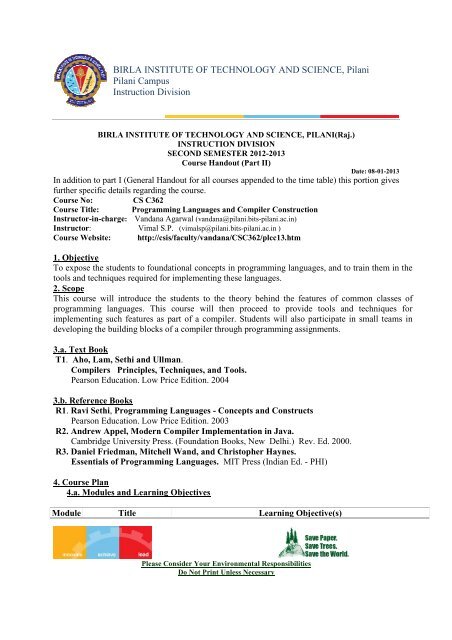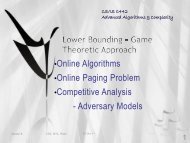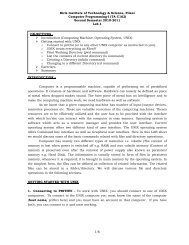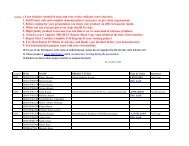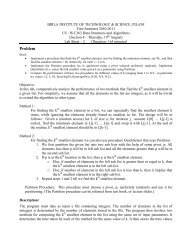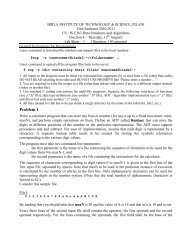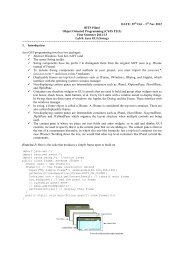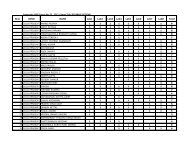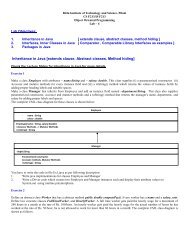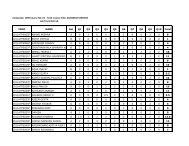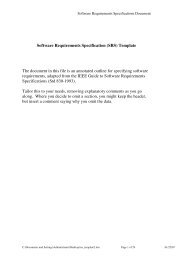Course Handout - Computer Science & Information Systems. BITS ...
Course Handout - Computer Science & Information Systems. BITS ...
Course Handout - Computer Science & Information Systems. BITS ...
Create successful ePaper yourself
Turn your PDF publications into a flip-book with our unique Google optimized e-Paper software.
BIRLA INSTITUTE OF TECHNOLOGY AND SCIENCE, Pilani<br />
Pilani Campus<br />
Instruction Division<br />
BIRLA INSTITUTE OF TECHNOLOGY AND SCIENCE, PILANI(Raj.)<br />
INSTRUCTION DIVISION<br />
SECOND SEMESTER 2012-2013<br />
<strong>Course</strong> <strong>Handout</strong> (Part II)<br />
Date: 08-01-2013<br />
In addition to part I (General <strong>Handout</strong> for all courses appended to the time table) this portion gives<br />
further specific details regarding the course.<br />
<strong>Course</strong> No: CS C362<br />
<strong>Course</strong> Title: Programming Languages and Compiler Construction<br />
Instructor-in-charge: Vandana Agarwal (vandana@pilani.bits-pilani.ac.in)<br />
Instructor: Vimal S.P. (vimalsp@pilani.bits-pilani.ac.in )<br />
<strong>Course</strong> Website: http://csis/faculty/vandana/CSC362/plcc13.htm<br />
1. Objective<br />
To expose the students to foundational concepts in programming languages, and to train them in the<br />
tools and techniques required for implementing these languages.<br />
2. Scope<br />
This course will introduce the students to the theory behind the features of common classes of<br />
programming languages. This course will then proceed to provide tools and techniques for<br />
implementing such features as part of a compiler. Students will also participate in small teams in<br />
developing the building blocks of a compiler through programming assignments.<br />
3.a. Text Book<br />
T1. Aho, Lam, Sethi and Ullman.<br />
Compilers Principles, Techniques, and Tools.<br />
Pearson Education. Low Price Edition. 2004<br />
3.b. Reference Books<br />
R1. Ravi Sethi, Programming Languages - Concepts and Constructs<br />
Pearson Education. Low Price Edition. 2003<br />
R2. Andrew Appel, Modern Compiler Implementation in Java.<br />
Cambridge University Press. (Foundation Books, New Delhi.) Rev. Ed. 2000.<br />
R3. Daniel Friedman, Mitchell Wand, and Christopher Haynes.<br />
Essentials of Programming Languages. MIT Press (Indian Ed. - PHI)<br />
4. <strong>Course</strong> Plan<br />
4.a. Modules and Learning Objectives<br />
Module Title Learning Objective(s)<br />
Please Consider Your Environmental Responsibilities<br />
Do Not Print Unless Necessary
P1<br />
P2<br />
P3<br />
C1<br />
C2<br />
C3<br />
C4<br />
BIRLA INSTITUTE OF TECHNOLOGY AND SCIENCE, Pilani<br />
Pilani Campus<br />
Instruction Division<br />
Introduction to Progg. To understand what programming languages provide programmers<br />
Languages<br />
with.<br />
Progg. (Language) To understand select programming paradigms, language support for<br />
Paradigms<br />
these paradigms and the impact of these paradigms on compilers.<br />
Programming To understand common features in programming languages and their<br />
Language Features foundational principles.<br />
Introduction to<br />
Compilers<br />
To understand the context and use of a compiler.<br />
Front End of a To understand the implementation of a front end of a compiler -<br />
Compiler<br />
scanning, parsing and semantic analysis.<br />
Back End of a To understand the implementation of a back end of a compiler -<br />
Compiler<br />
Activation Records, Code Generation and Register allocation.<br />
Special aspects of To understand some special aspects of compilers and runtime such as<br />
compilers and runtime code optimization, garbage collection, and scheduling of instructions.<br />
4.b. Lecture Schedule<br />
Lec. Topic Module Reading<br />
1 Computability & Programming. Machine models & Programming<br />
Language(s).<br />
P1 Notes<br />
2<br />
Execution models. Compilation vs. Interpretation. Intermediate<br />
languages. Virtual Machines.<br />
C1 Notes<br />
3-4<br />
Structure and Components of a compiler. Phases vs Passes.<br />
Compile-time versus Run-time. Bootstrapping<br />
C1<br />
T1 Ch1,<br />
Ch11<br />
5-6<br />
Lexical Analysis-Tokens, patterns, lexemes, Transition Diagram<br />
based Lexical Analysis<br />
C2 T1 Ch. 3<br />
7-9<br />
Syntax Analysis: Top Down Parsing- LL(1) Grammars, Recursive<br />
Descent Parsing, Non Recursive Predictive parsing<br />
C2 T1 Ch 4<br />
10-12<br />
Syntax Analysis: Bottom Up Parsing- LR parsing, LR(0), SLR,<br />
LR(1), LALR Parsers<br />
C2 T1 Ch 4<br />
13-14 Parse Tree; Abstract Syntax; Static Analyses C2 T1 Ch. 5<br />
15-16<br />
Programming Styles and Programming Language Paradigms.<br />
Declarative and Operational Paradigms<br />
P2<br />
R1 Ch. 7,8<br />
and 10<br />
17-19<br />
(Programming) Language Models; Lambda Calculus and<br />
Recursive Functions<br />
P1<br />
R1 Chs.<br />
13and 14<br />
20 Types and Data Representation – Primitive and Structured Types;<br />
Function Types;<br />
P3 R1 Ch. 4<br />
21-22 ADTs; Polymorphism; Recursive Types, Objects and Subtyping P3 Notes<br />
23 Type Checking and Type Inferencing C2 R1. Ch 4 &<br />
Please Consider Your Environmental Responsibilities<br />
Do Not Print Unless Necessary
BIRLA INSTITUTE OF TECHNOLOGY AND SCIENCE, Pilani<br />
Pilani Campus<br />
Instruction Division<br />
24-25<br />
Functions: Parameter Passing Techniques, Scope Rules, Binding<br />
Times, Higher Order Functions.<br />
P3<br />
T1 Ch 6.<br />
Notes<br />
26-27<br />
Runtime Memory Models - Call Stacks and Frames, Static and<br />
Dynamic Links<br />
P3 /<br />
C3<br />
R1 Ch 5&<br />
T1 Ch 7<br />
28 Runtime Memory Models – Data / Object Representation<br />
P3 /<br />
C3<br />
Notes &<br />
R2 Ch. 14<br />
29-30 Intermediate Representation; Intermediate Language C3 T1 Ch. 6<br />
31-33 Code Generation and optimization issues C3 T1 Ch. 8<br />
34-37<br />
Data Flow Equations. Liveness analysis; Register Allocation C4<br />
T1 Chs.8,<br />
9<br />
38 Garbage Collection C4 R2 Ch. 13<br />
39-40<br />
Architectural Issues and Compilers – Pipelining, Caching and<br />
Instruction Scheduling<br />
C4<br />
R2 Chs.<br />
20-21<br />
5. Evaluation Scheme<br />
5.a. Major Components<br />
Component Mode Duration Date Weight<br />
Mid Semester<br />
Test<br />
Open Book 90min 2/3 11:00 - 12:30 PM 25%<br />
Quiz Closed Book 50min TBA 10%<br />
Compiler<br />
Project<br />
Lab (Take home)<br />
30%<br />
Comprehensive Partially Closed Book/Open book 3 hours 13/5 AN 35%<br />
5.b.Compiler Project:<br />
• The project will be implemented by students (in a team of 2) in TWO stages/<br />
components.<br />
• Timely submitted components will be evaluated individually through a viva-voce,<br />
demonstration or may be evaluated offline.<br />
• Only originally created code will be evaluated. Both students of the team submitting<br />
plagiarized code will be penalized as per the malpractice regulations.[refer 5(c)]<br />
• Compiler components are to be completed in time with no postponements.<br />
• Each team gets only ONE lifeline over the semester. A lifeline allows the team to submit<br />
the code at most 24 hours late without any penalty.<br />
Please Consider Your Environmental Responsibilities<br />
Do Not Print Unless Necessary
BIRLA INSTITUTE OF TECHNOLOGY AND SCIENCE, Pilani<br />
Pilani Campus<br />
Instruction Division<br />
• Once the lifeline has been used up, 24 hour delays may be permitted for submission of<br />
the second stage at the penalty of 25% weight for that component. No submissions are<br />
allowed after 24 hours from deadline.<br />
• Each stage should be developed incrementally.<br />
• If a team of students does not complete/ get fully functional code for larger set of features<br />
or operations as expected at any stage, the team will be allowed to submit the code that<br />
works correctly for less features, operations etc. The marks will be allotted partially as<br />
per the criteria. However, the partially working code of an previous stage may be a<br />
limitation for the later stages, which students may have to work out to be able to have the<br />
later stage code get appropriate input from the previous stage.<br />
Compiler Project Components<br />
Stage Title Duration Weight<br />
1<br />
Lexical Analyzer, Parser, syntax Analysis, Syntax<br />
Tree Generation<br />
5 weeks 15%<br />
2<br />
Symbol table, Semantic Analysis, Code Generation<br />
and Compiler Integration<br />
5 weeks 15%<br />
5.c. Malpractice Regulations:<br />
The following regulations are supplementary to <strong>BITS</strong>-wide policies regarding malpractices:<br />
1. Any student or team of students found involved in mal practices in working out<br />
assignments / projects will be awarded a zero for that assignment / project and will<br />
be blacklisted. Note that the entire project component will be awarded zero,<br />
irrespective of the stage at which the mal practice is found.<br />
2. Any student or team of students found repeatedly – more than once across all<br />
courses – involved in mal-practices will be reported to the Disciplinary Committee<br />
for further action. This will be in addition to the sanction mentioned above.<br />
3. A mal-practice - in this context - will include but not be limited to:<br />
submitting some other student’s / team’s solution(s) as one’s own;<br />
copying some other student’s / team’s data or code or other forms of a<br />
solution;<br />
seeing some other student’s / team’s data or code or other forms of a<br />
solution;<br />
permitting some other student / team to see or to copy or to submit one’s<br />
own solution;<br />
Please Consider Your Environmental Responsibilities<br />
Do Not Print Unless Necessary
BIRLA INSTITUTE OF TECHNOLOGY AND SCIENCE, Pilani<br />
Pilani Campus<br />
Instruction Division<br />
OR other equivalent forms of plagiarism wherein the student or team does<br />
not work out the solution and/or uses some other solution or part thereof<br />
(such as downloading it from the web).<br />
4. The degree of mal-practice (the size of the solution involved or the number of students<br />
involved) will not be considered as mitigating evidence. Failure on the part of instructor(s)<br />
to detect mal-practice at or before the time of evaluation may not prevent sanctions later<br />
on.<br />
6. Notices: All notices concerning this course will be put on the IPC notice board OR the course website<br />
as appropriate.<br />
7. Makeup Policy:<br />
- Permission of the Instructor-in-Charge is required to take a make-up<br />
- Make-up applications must be given to the Instructor-in-charge personally.<br />
- A make-up test shall be granted only in genuine cases where - in the Instructor’s judgment - the<br />
student would be physically unable to appear for the test.<br />
- In case of an unanticipated illness preventing a student from appearing for a test, the student must<br />
present a Medical Certificate from <strong>BITS</strong> hospital.<br />
- In case of unanticipated absence for a test due to a trip out of Pilani, the student must present a<br />
letter from his/her Warden or the Chief Warden certifying such absence and the reason(s).<br />
- Requests for make-up for the comprehensive examination – under any circumstances – can only be<br />
made to Dean, Instruction Division.<br />
Instructor-in-charge<br />
CS C362<br />
Please Consider Your Environmental Responsibilities<br />
Do Not Print Unless Necessary


